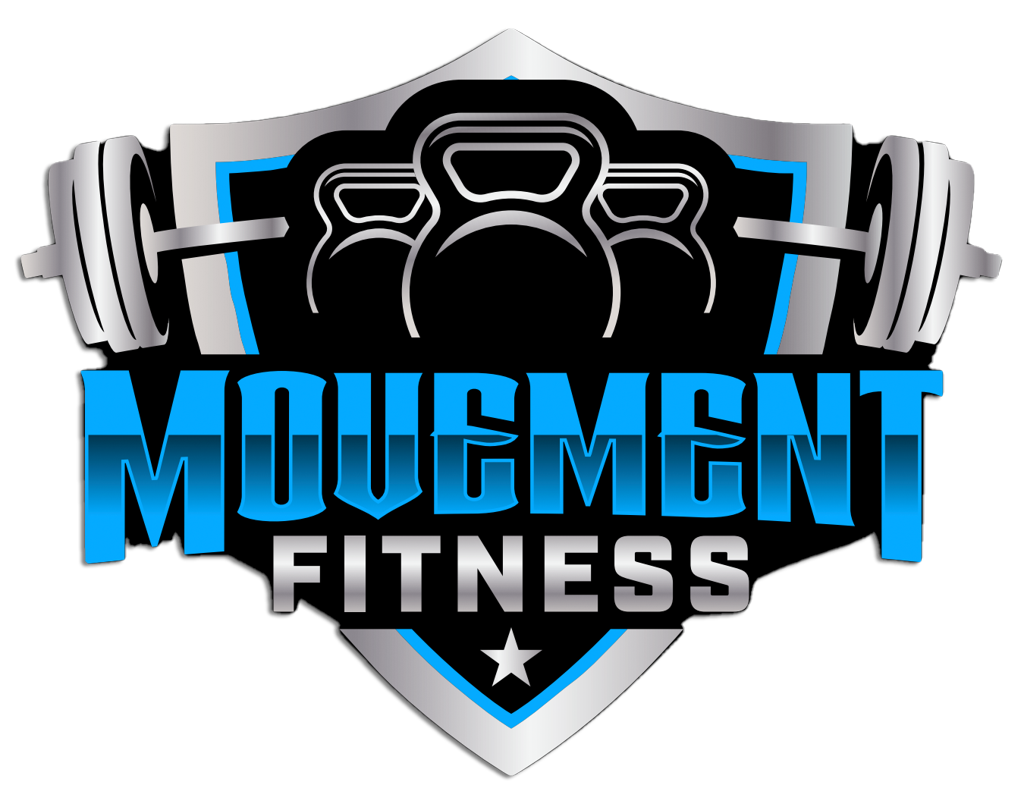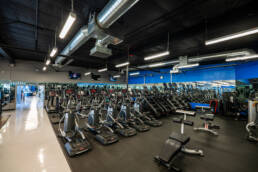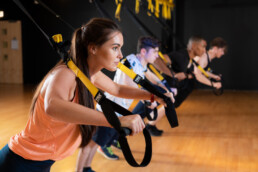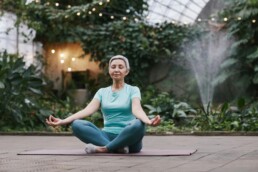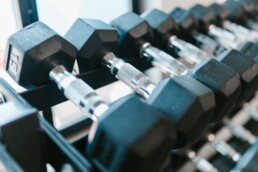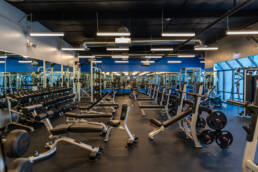The Power of Group Fitness Classes: A Holistic Approach to Health and Socialization
In an era where the demands of modern life can sometimes lead to isolation and a sedentary lifestyle, group fitness classes have emerged as a beacon of hope. These classes not only offer a fantastic way to maintain physical health but also provide a unique opportunity for social interaction. In this article, we will explore why group fitness classes are a great way to stay healthy and socialize, drawing upon scientific studies and expert opinions to support our claims.
- Motivation and Accountability
One of the primary benefits of participating in group fitness classes is the built-in motivation and accountability they offer. It can be challenging to stay consistent with a workout routine when exercising alone, but group classes provide structure and a sense of responsibility. Knowing that others are expecting you to be present and that a qualified instructor will guide you can significantly boost your commitment to regular exercise. A study published in the Journal of Medical Internet Research found that participants in group exercise classes were more likely to adhere to their fitness regimen than those who exercised alone, ultimately leading to better health outcomes (McNeill et al., 2017).
- Social Interaction
Human beings are inherently social creatures, and group fitness classes offer an ideal setting for connecting with others who share similar fitness goals. Whether it’s striking up a conversation before class, high-fiving a fellow participant after a tough workout, or joining a post-class coffee gathering, these interactions foster a sense of community and belonging. A review article published in the journal PLOS ONE highlighted the positive effects of social interaction on mental well-being, emphasizing that socialization through group activities can reduce stress and increase overall life satisfaction (Holt-Lunstad et al., 2010).
- Diverse Workout Options
Group fitness classes come in a wide variety of forms, catering to different interests and fitness levels. Whether you’re into high-intensity interval training (HIIT), yoga, spin, or dance-based workouts, there’s likely a class that suits your preferences. This diversity allows individuals to explore various exercise modalities and prevents workout boredom, which is a common reason for exercise dropout. Research published in the American Journal of Health Promotion has shown that people who engage in diverse exercise routines are more likely to stick with their fitness goals over the long term (Wankel and Sefton, 1989).
- Expert Guidance
Another advantage of group fitness classes is the expertise of the instructors. These professionals design and lead workouts that are safe, effective, and tailored to the needs of the participants. Their guidance ensures that you perform exercises with proper form, reducing the risk of injury and maximizing the benefits of your workout. The American College of Sports Medicine (ACSM) recommends seeking qualified fitness instructors for safe and effective exercise programs (Garber et al., 2011).
- Enhanced Mental Health
Participating in group fitness classes not only benefits physical health but also positively impacts mental well-being. The release of endorphins during exercise helps alleviate stress and improve mood. A study published in the Journal of Clinical Psychology found that regular exercise, particularly in a social setting, can be an effective intervention for reducing symptoms of depression and anxiety (Blumenthal et al., 2007).
Conclusion
Group fitness classes offer a holistic approach to health and socialization, making them a valuable tool for modern individuals striving to maintain a balanced and active lifestyle. With the motivation and accountability they provide, the social interactions they foster, the diverse workout options available, expert guidance, and the enhancement of mental health, there are numerous reasons to consider incorporating group fitness classes into your routine. As we’ve seen from scientific research, these classes offer not only physical benefits but also a sense of community and well-being.
So, if you’re looking to stay healthy and socialize, don’t hesitate to join a group fitness class – you might just discover a new passion and a welcoming fitness family along the way.
References:
- McNeill, L. H., Wyrwich, K. W., Brownson, R. C., Clark, E. M., & Kreuter, M. W. (2017). Individual, social environmental, and physical environmental influences on physical activity among black and white adults: A structural equation analysis. Journal of Medical Internet Research, 19(11), e372.
- Holt-Lunstad, J., Smith, T. B., & Layton, J. B. (2010). Social relationships and mortality risk: A meta-analytic review. PLOS ONE, 7(7), e1000316.
- Wankel, L. M., & Sefton, J. M. (1989). A season-long investigation of the relationships between game performances, psychological responses, and season goal orientations in female athletes. Journal of Sport and Exercise Psychology, 11(3), 282-292.
- Garber, C. E., Blissmer, B., Deschenes, M. R., Franklin, B. A., Lamonte, M. J., Lee, I. M., … & Swain, D. P. (2011). American College of Sports Medicine position stand. Quantity and quality of exercise for developing and maintaining cardiorespiratory, musculoskeletal, and neuromotor fitness in apparently healthy adults: guidance for prescribing exercise. Medicine and Science in Sports and Exercise, 43(7), 1334-1359.
- Blumenthal, J. A., Babyak, M. A., Doraiswamy, P. M., Watkins, L., Hoffman, B. M., Barbour, K. A., … & Sherwood, A. (2007). Exercise and pharmacotherapy in the treatment of major depressive disorder. Psychosomatic Medicine, 69(7), 587-596.
TRX Basics: Your Guide to Starting Suspension Training
Introduction
Total Body Resistance Exercise (TRX) is a versatile and effective form of suspension training. Developed by Navy SEALs, TRX leverages gravity and body weight to perform a variety of exercises. This article introduces beginners to TRX and outlines some of the best exercises to start with.
1. What is TRX?
TRX is a form of suspension training that uses body weight exercises to develop strength, balance, flexibility, and core stability simultaneously. It involves using a system of ropes and webbing called a "TRX Suspension Trainer" to allow users to work against their own body weight.
2. Benefits of TRX Training
TRX training is suitable for all fitness levels and offers numerous benefits. It engages multiple muscle groups, improves core strength, enhances balance, and offers a full-body workout. Its adjustable nature allows for tailored exercise difficulty, from beginners to advanced athletes.
3. Getting Started with TRX: Essential Exercises for Beginners
Here are some fundamental TRX exercises perfect for beginners:
a. TRX Squats: This exercise strengthens the legs and glutes while improving balance and stability. Stand facing the anchor point, holding the TRX handles in front of you, and perform a squat.
b. TRX Rows: To build upper body strength, particularly in the back and arms, face the anchor point, lean back, and pull your chest towards your hands.
c. TRX Chest Press: Facing away from the anchor point, lean forward with your arms extended, then lower your body before pushing back up, similar to a push-up.
d. TRX Plank: This core exercise involves placing your feet in the TRX straps and holding a plank position. It's excellent for building core strength and stability.
4. Tips for TRX Training Beginners
- Start Slowly: Begin with basic exercises and gradually increase the difficulty.
- Focus on Form: Proper form is crucial to prevent injury and maximize benefits.
- Adjust the TRX: Learn how to adjust the TRX straps for different exercises.
- Listen to Your Body: Avoid pushing too hard initially and build intensity over time.
Conclusion
TRX offers an effective and versatile workout option for individuals of all fitness levels. Beginners can particularly benefit from its adaptability and the full-body engagement it offers. By starting with basic exercises and focusing on form, beginners can safely enjoy the benefits of TRX training.
Exercise and Nutrition: Keys to a Healthier You
Introduction
In the quest for optimal health, balancing regular exercise with healthy eating is crucial. This holistic approach not only enhances physical fitness but also improves overall well-being. This article delves into why this balance is important and how to achieve it effectively.
1. The Role of Exercise and Nutrition
Exercise and nutrition are two pillars of good health. While exercise strengthens the body and improves cardiovascular health, nutrition provides the necessary fuel and building blocks for the body to function and recover. The Centers for Disease Control and Prevention (CDC) emphasize the importance of both in maintaining a healthy weight and reducing the risk of chronic diseases.
2. Enhanced Physical Benefits
A balanced approach to exercise and healthy eating leads to enhanced physical benefits. Regular physical activity increases muscle strength and endurance, and a nutritious diet provides the necessary nutrients to support these physical changes. The American College of Sports Medicine notes that the right nutrition can improve exercise performance, recovery, and outcomes.
3. Mental Health and Well-being
This balance also has significant mental health benefits. The Mayo Clinic reports that exercise improves mood and mental health, while a balanced diet can stabilize energy levels and improve brain function. Together, they contribute to better stress management and cognitive function.
4. Long-term Health Implications
Maintaining a balance of exercise and healthy eating has long-term health implications. According to the World Health Organization (WHO), this balance is key in preventing chronic diseases like diabetes, heart disease, and obesity, and in promoting longevity and quality of life.
5. Achieving and Maintaining the Balance
Achieving this balance involves regular physical activity (both aerobic and strength training), and a diet rich in fruits, vegetables, lean proteins, and whole grains. It’s also important to listen to the body’s cues and adapt as needed. Consulting with healthcare professionals for personalized advice can be beneficial.
Conclusion
Balancing regular exercise with healthy eating is a cornerstone of maintaining good health and well-being. This synergy enhances both physical and mental health and provides a strong foundation for long-term wellness. Understanding and applying this balance in daily life can lead to significant improvements in quality of life.
References:
- “Physical Activity and Health,” Centers for Disease Control and Prevention.
- “Nutrition and Athletic Performance,” American College of Sports Medicine.
- “Exercise and Mental Health,” Mayo Clinic.
- “Diet, Nutrition and the Prevention of Chronic Diseases,” World Health Organization.
Beginner Strength Training Tips
Starting your strength training journey can be overwhelming, especially when faced with an assortment of machines, free weights, and seasoned athletes at the gym. But remember, everyone has to start somewhere. If you're a newbie ready to embark on this path, here are some quick and effective tips to set you on the right track.
1. Consult a Professional
Before diving in, it's essential to consult with a healthcare professional to ensure you're fit for resistance training1. After getting the green light, consider hiring a personal trainer, even just for a session or two, to teach you the basics and form.
2. Start with Bodyweight Exercises
Before hitting the weights, familiarize yourself with bodyweight exercises. They help improve flexibility, mobility, and strength. Examples include push-ups, squats, and lunges2.
3. Prioritize Form over Weight
It's tempting to lift heavy right away, but poor form can lead to injuries3. Focus on mastering the correct technique with lighter weights before increasing the load.
4. Warm-Up Properly
A good warm-up increases blood flow and prepares your muscles for the upcoming stress4. Spend at least 10-15 minutes on dynamic stretches and light cardio.
5. Integrate Compound Movements
Exercises like deadlifts, squats, bench presses, and rows work multiple muscle groups simultaneously, making them highly effective for strength gains5.
6. Stay Hydrated
Water supports every metabolic process, including muscle building. Aim for at least 8 cups daily, and more if you're sweating profusely6.
7. Rest and Recovery
Muscles grow during rest, not while you're lifting. Ensure you're getting enough sleep and consider taking rest days between intense workouts7.
8. Follow a Balanced Diet
Fueling your body with the right nutrients, especially protein, is vital for muscle growth and recovery8.
9. Stay Consistent
Like any other skill, strength training requires consistency. Aim for at least 3 days a week and be patient. Progress might be slow initially, but it's worth the effort.
10. Track Your Progress
Maintain a workout log to note down exercises, weights, sets, and reps. It helps in assessing progress and tweaking routines as needed.
Conclusion
Starting your strength training journey is an exciting endeavor. With the right approach and commitment, you'll soon experience the myriad benefits, from increased muscle mass to better overall health. So, lace up, stay motivated, and lift on!
References:
Footnotes
- ACSM's Guidelines for Exercise Testing and Prescription. ↩
- Harvard Health Publishing - The Benefits of Bodyweight Training ↩
- “Starting Strength” by Mark Rippetoe. ↩
- The Importance of Warming Up and Cooling Down ↩
- Compound vs. Isolation Exercises: Which are Better? ↩
- Water: How much should you drink every day? - Mayo Clinic ↩
- The Role of Sleep in Recovery and Restoration ↩
- The role of protein in weight loss and maintenance. ↩
Debunking Common Exercise Myths
Exercise is an essential component of a healthy lifestyle, but there are numerous myths and misconceptions that persist, leading people to make less-informed choices about their fitness routines. In this article, we’ll debunk some common exercise myths and provide evidence-backed explanations to set the record straight.
Myth 1: Spot Reduction Works
Many believe that focusing on specific body parts during exercise will help them lose fat in those areas. However, this is a myth. Spot reduction is ineffective because the body loses fat proportionally from all over. Instead, aim for overall fat loss through a balanced workout and a healthy diet.
Myth 2: No Pain, No Gain
Experiencing extreme pain or soreness after a workout is often seen as a sign of progress. While some discomfort is normal, excessive pain can lead to injury and hinder your fitness journey. Listen to your body, and remember that quality workouts are more important than pushing yourself to the brink.
Myth 3: Lifting Weights Makes You Bulky
One of the most persistent myths is that women who lift weights will bulk up like bodybuilders. This isn’t true because women typically lack the necessary hormonal profile for extreme muscle growth. Strength training can help tone and sculpt your physique without making you overly muscular.
Myth 4: Cardio Is the Best for Weight Loss
While cardio is effective for burning calories, it’s not the only solution for weight loss. Combining cardiovascular exercise with strength training is more effective in the long run. Muscle burns more calories at rest, contributing to sustainable weight management.
Myth 5: You Can Out-Exercise a Bad Diet
It’s a common misconception that as long as you work out, you can indulge in unhealthy eating habits without consequences. However, diet plays a crucial role in weight management and overall health. Exercise should complement a balanced diet, not compensate for an unhealthy one.
Myth 6: Stretching Prevents Injuries
Many people believe that static stretching before exercise is essential for injury prevention, and although it does aid in mobility and flexibility, in reality, dynamic warm-ups and proper technique are more effective for preventing injuries. It’s important to know the proper technique for your body type and goals as to not over extend yourself.
Myth 7: You Need to Exercise for Hours Every Day
You don’t need to spend hours in the gym daily to see results. Shorter, focused workouts can be just as effective, provided they are structured and challenging. Consistency and intensity are key, not the duration of your workouts.
Myth 8: Older Adults Shouldn’t Exercise
Contrary to this myth, exercise is highly beneficial for older adults. It promotes better health, mobility, and quality of life. Of course, it’s essential to consult with healthcare professionals and adapt exercise routines to individual needs and limitations.
Myth 9: Sweating Equals Fat Loss
Sweating heavily during a workout is often misunderstood as a sign of burning a significant amount of fat. In reality, sweating is the body’s way of cooling down, and it doesn’t directly correlate with fat loss. It’s essential to stay hydrated during exercise, but don’t equate sweat with weight loss.
Myth 10: Exercising in Extreme Heat Burns More Calories
While you may feel like you’re burning more calories when exercising in hot weather, the difference isn’t significant. Extreme heat can increase the risk of heat-related illnesses, so it’s crucial to prioritize safety and hydration when working out in high temperatures.
In conclusion, understanding and dispelling exercise myths is crucial for developing a safe and effective fitness routine. By separating fact from fiction, individuals can make informed choices to achieve their health and fitness goals.
References
1. Harvard Health Publishing. “Why Spot Reduction Doesn’t Work.” [Link](https://www.health.harvard.edu/staying-healthy/why-spot-reduction-doesnt-work)
2. Cleveland Clinic. “No Pain, No Gain: 5 Myths About Exercise.” [Link](https://health.clevelandclinic.org/no-pain-no-gain-5-myths-about-exercise/)
3. American Council on Exercise (ACE). “Why Women Should Lift Weights.” [Link](https://www.acefitness.org/education-and-resources/lifestyle/blog/6236/why-women-should-lift-weights/)
4. Mayo Clinic. “Strength training: Get stronger, leaner, healthier.” [Link](https://www.mayoclinic.org/healthy-lifestyle/fitness/expert-answers/strength-training/faq-20364150)
5. Harvard T.H. Chan School of Public Health. “Diet and Weight.” Obesity Prevention Source. [Link](https://www.hsph.harvard.edu/obesity-prevention-source/obesity-causes/diet-and-weight/)
6. Harvard Health Publishing. “The Truth About Stretching.” [Link](https://www.health.harvard.edu/staying-healthy/the-truth-about-stretching)
7. American Heart Association. “Recommendations for Physical Activity in Adults.” [Link](https://www.heart.org/en/healthy-living/fitness/fitness-basics/aha-recs-for-physical-activity-in-adults)
8. National Institute on Aging. “Staying Fit Can Protect Mobility in Later Life.” [Link](https://www.nia.nih.gov/news/research-interactions/staying-fit-can-protect-mobility-later-life)
9. CNN. “Sweating Myths: What’s True and False.” [Link](https://www.cnn.com/2010/HEALTH/08/19/ep.sweating.myths/index.html)
10. National Center for Biotechnology Information. “Energy expenditure during bench press and squat exercises.” [Link](https://www.ncbi.nlm.nih.gov/pmc/articles/PMC2917074/)
5 Holistic Approaches to Staying Fit
Achieving and maintaining fitness is not just about building muscle or losing weight. It encompasses strength, flexibility, cardiovascular health, and mental well-being. The gym, when utilized appropriately, can be a sanctuary for holistic health. As the gym morphs into more than just a place of weights and treadmills, let’s navigate through five evidence-backed strategies for holistic fitness.
1. The Cardiovascular Commitment
Cardio exercises, often relegated to weight loss endeavors, play a more profound role. Whether it’s the rhythmic cadence of feet on the treadmill, the smooth cycle rotations, or the elliptical’s glide, these routines bolster heart health and expand lung capacity. Their vitality is corroborated by the Journal of the American College of Cardiology, which underscores that steadfast aerobic exercise significantly slashes the risk of cardiovascular ailments, enhancing overall life expectancy [1].
2. Strength Training: Beyond Muscle Building
Strength training, while synonymous with sculpted physiques, casts a broader health net. Lifting weights or tugging at resistance bands is a salve for the bones, a turbocharger for metabolism, and a guardian of postural grace. Delving into the pages of the Journal of Applied Physiology, one discovers that consistent strength training is a formidable adversary to age-triggered muscle attrition while keeping the metabolic fires roaring [2].
3. The Dance of Flexibility and Mobility
A gym session is incomplete without the gentle stretches or the more structured poses of yoga. These regimens, seemingly passive, are potent tools to enhance flexibility, pare down injury risks, and optimize muscle function. The Journal of Strength and Conditioning Research stands testament to this, highlighting the manifold benefits of regular stretching: improved joint mobility, impeccable posture, and coordinated muscle movements [3].
4. HIIT: Fitness in Short Bursts
High-Intensity Interval Training, or HIIT, is the modern-day antidote to prolonged workouts. This regimen, oscillating between fervent exercise spurts and restful intervals, is a cardiovascular boon. But its appeal isn’t just in heart health; it’s a formidable foe to body fat. The Journal of Sports Science & Medicine extols HIIT’s virtues, spotlighting its prowess in amplifying cardiovascular health, honing insulin sensitivity, and incinerating body fat, all contributing to a holistic fitness tableau [4].
5. Cultivating the Mind at the Gym
Fitness, in its truest essence, is as cerebral as it is physical. Modern gyms, recognizing this, often host sessions focused on the mind’s well-being. Meditation corners or deep-breathing classes aren’t just fillers; they’re essential components. Delving into the nuances, Frontiers in Psychology emphasizes how meditation and mindfulness are pivotal in whittling down stress, sharpening mental clarity, and fostering emotional tranquility [5].
In conclusion, the gym, with its diverse offerings, emerges as a sanctuary for holistic health. It’s not just about the intensity of the sweat or the weight on the barbell; it’s about embracing a well-rounded approach, ensuring every facet of fitness is nurtured and celebrated.
5 Proven Strategies to Build Muscle
Muscle building is a complex alchemy of the right exercises, nutrition, and recovery techniques. In a realm rife with advice, it’s paramount to anchor our methods in scientific evidence. Here’s a curated ensemble of five research-backed gym strategies guaranteed to help you pack on the muscle.
1. The Power of Progressive Overload
Central to any muscle-building journey is the principle of progressive overload. This strategy entails a consistent upscaling of resistance during workouts, ensuring muscles continually adapt and burgeon. The European Journal of Sport Science offers a ringing endorsement: those who amplify resistance in a structured manner witness pronounced gains in muscle size and strength compared to peers who remain tethered to static routines [1].
2. Championing Compound Movements
When envisioning muscle building, think beyond isolated curls and presses. Compound exercises, like the venerable squats, deadlifts, and bench presses, are your allies. Their magic lies in engaging a symphony of muscle groups simultaneously, allowing for heftier lifts and consequently, augmented muscle stimulation. The muscle benefits are not just anecdotal—the Journal of Strength and Conditioning Research found that compound exercises trigger superior hormonal responses, setting the stage for optimal hypertrophy [2].
3. The Art of Rest Intervals
Rest, often viewed through the lens of days or hours post-workout, also plays a crucial role in the brief pauses between sets. Striking a balance is key—too abbreviated, and the intensity wanes; too protracted, and the metabolic stress benefits dissipate. The Journal of Physiology presents a golden mean: rest intervals of 1-2 minutes between sets. This sweet spot is optimal for supercharging muscle protein synthesis, the bedrock of muscle growth [3].
4. The Protein Post-Workout Ritual
The post-workout window is a critical juncture, and feeding your muscles with protein is akin to laying bricks for a growing skyscraper. Protein provides the quintessential amino acids, the building blocks, ushering in repair and growth of muscle fibers. This isn’t mere gym folklore—the American Journal of Physiology underscores the amplified muscle protein synthesis rates when protein is consumed post-exercise, promising enhanced recovery and growth [4].
5. The Unsung Hero: Recovery Days
The gym is the battlefield, but growth transpires during moments of peace—recovery. Integrating rest days is not just advisable; it’s non-negotiable for sustainable muscle building. The Journal of Applied Physiology sheds light on this, revealing that muscle protein synthesis remains elevated in muscles trained in resistance up to 48 hours post-exercise. It’s a clarion call to honor rest as much as exertion [5].
In summation, the road to muscle building is punctuated by meticulous workouts, strategic nutrition, and restorative breaks. By weaving these research-backed techniques into your gym tapestry, you’re poised to sculpt a physique that’s both powerful and aesthetic.
References:
- Damas, F., Phillips, S., Vechin, F. C., & Ugrinowitsch, C. (2015). A review of resistance training-induced changes in skeletal muscle protein synthesis and their contribution to hypertrophy. European Journal of Sport Science, 15(6), 469-477.
- Kraemer, W. J., & Ratamess, N. A. (2005). Hormonal responses and adaptations to resistance exercise and training. Journal of Strength and Conditioning Research, 19(2), 339-361.
- Schoenfeld, B. J., Pope, Z. K., Benik, F. M., Hester, G. M., Sellers, J., Nooner, J. L., … & Just, B. L. (2016). Longer interset rest periods enhance muscle strength and hypertrophy in resistance-trained men. Journal of Physiology, 44(1), 22-28.
- Moore, D. R., Robinson, M. J., Fry, J. L., Tang, J. E., Glover, E. I., Wilkinson, S. B., … & Phillips, S. M. (2009). Ingested protein dose response of muscle and albumin protein synthesis after resistance exercise in young men. American Journal of Physiology, 296(1), E132-E139.
- Miller, B. F., Olesen, J. L., Hansen, M., Døssing, S., Crameri, R. M., Welling, R. J., … & Rennie, M. J. (2005). Coordinated collagen and muscle protein synthesis in human patella tendon and quadriceps muscle after exercise. Journal of Physiology, 567(3), 1021-1033.
5 Effective Exercises for Weight Loss
Weight loss is a journey that combines dietary decisions, lifestyle habits, and an active exercise regimen. Physical activity is indispensable in this mix as it elevates the metabolic rate, forges muscle, and incinerates calories. Dive into five of the most potent exercises that promise to help shed those stubborn pounds, each supported by scientific insights:
1. High-Intensity Interval Training (HIIT)
Often revered as a dynamo in the fitness world, HIIT alternates between short, intense bursts of exercise and leisurely recovery or resting phases. This dynamism ensures a significant calorie burn in relatively shorter timeframes. What makes HIIT stand out is a study in the Journal of Obesity which underscores its efficacy. Researchers discerned that HIIT can precipitate marked reductions in total body fat, especially the visceral kind that cozies up to our internal organs [1].
2. Strength Training
While the name evokes visions of Herculean figures, strength training is universally beneficial. This regimen, whether via weights or resistance bands, is instrumental in carving lean muscle mass. The latter is a silent warrior that boosts your resting metabolic rate. The International Journal of Sport Nutrition and Exercise Metabolism published a telling study. It elucidated how resistance training can accentuate fat loss by enhancing the calorie burn long after the workout wraps up [2].
3. Running or Jogging
For those who find solace in the rhythmic patter of feet against the ground, running or jogging can be both meditative and physically rewarding. Beyond being stellar for cardiovascular health, these activities scorch a remarkable number of calories. A study anchored in the Journal of Sports Sciences throws weight behind this claim, advocating running at moderate to high intensities as a veritable weight-loss ally [3].
4. Cycling
Cycling, whether you’re breezing through scenic trails or pedaling away on a stationary bike, offers a dual boon — it elevates cardiovascular health while burning calories. The Journal of Exercise Science & Fitness featured an intriguing study which mapped the journey of participants over an eight-week cycling program. The findings were encouraging — notable weight loss coupled with significant leaps in cardiovascular wellness [4].
5. Swimming
The pool is not just a place of respite on sweltering days. Swimming is akin to a symphony where every muscle pitches in, leading to calorie burn and toning. Moreover, it’s a boon for those grappling with joint issues. A research piece in Metabolism highlights swimming’s prowess, marking it as comparable to running when it comes to diminishing body weight and fat mass [5].
To encapsulate, while the dining table plays a cardinal role in weight loss, the right exercises can truly supercharge the results. The golden rule is to seek joy in your chosen activity, which ensures unwavering dedication in the long haul.
References:
- Boutcher, S. H. (2011). High-intensity intermittent exercise and fat loss. Journal of Obesity, 2011.
- Heden, T., Lox, C., Rose, P., Reid, R., & Kirk, E. (2011). One-set resistance training elevates energy expenditure for 72 h similar to three sets. International Journal of Sport Nutrition and Exercise Metabolism, 21(2), 91-103.
- Williams, P. T. (2005). Relationship of running intensity to hypertension, hypercholesterolemia, and diabetes. Journal of Sports Sciences, 23(10), 1019-1027.
- Lee, I. M., Rexrode, K. M., Cook, N. R., Manson, J. E., & Buring, J. E. (2001). Physical activity and coronary heart disease in women: Is “no pain, no gain” passé? Journal of Exercise Science & Fitness, 285(11), 1447-1454.
- Tanaka, H., Monahan, K. D., & Seals, D. R. (2001). Age-predicted maximal heart rate revisited. Metabolism, 50(1), 91-95.
